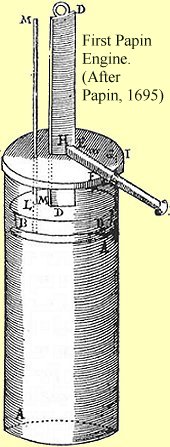How Can We Use Steam?
Today, we wonder how to make use of steam. The University of Houston's College of Engineering presents this series about the machines that make our civilization run, and the people whose ingenuity created them.
During the seventeenth century, we finally tumbled to the fact that gases and vapors can exert huge forces. People began testing the idea that airy vapor might actually power an engine. Rudimentary steam engines began appearing.
As early as 1606 (or 1601?) an Italian experimenter showed how steam, forced into a closed box of water, could drive the water up a pipe. He had made an embryonic steam pump a century before Thomas Newcomen built the first complete working engine in England, and 160 years before James Watt began making steam engine improvements.
So think for a moment like a seventeenth-century inventor. You realize steam has a huge potential and you want a machine that can harness it. What options do you have?
By now we've settled on two very different means. We can expand steam through a nozzle and let the resulting jet do work for us. Or we can let steam act upon a piston.
First-century Hellenistic engineers used rear-pointing steam jets to power toys -- birds flying on the ends of strings, whirligig devices, vehicles. Another Italian inventor described a complete steam turbine system to power grinding pestles, in 1629. His jet acted upon a turbine wheel, instead of just blowing backward. And, despite all that, p ractical steam turbines wouldn't appear until just over a hundred years ago.
ractical steam turbines wouldn't appear until just over a hundred years ago.
The piston/cylinder idea is more complex in principle. But it was easier to make. Consider possibilities: You can seal some water in a cylinder, then alternately heat and cool it. Boil and condense -- driving a piston first one way, then the other.
Or you can supply steam from an external boiler. First the steam pushes the piston one direction. Then we condense the steam and outside air pushes it the other way. Or we can exhaust the spent steam and let it condense outside the cylinder. Lots of possibilities there, and all of them were tried.
Denis Papin, a French Huguenot working in Germany, built the first piston engine in 1690. He heated and condensed the same water over and over. It was slow, and he didn't yet have the mechanical wherewithal to make a commercial model. Seventeen years later Papin described another engine. This time he supplied steam from an outside boiler and he exhausted the spent steam. After another five years, Thomas Newcomen built his working engine. He used an external boilerm he condensed his steam inside the cylinder, and he gave us the beginning of commercial steam engines.
But so many clever people had brought it into being. By the time working engines could take so much weight off our backs, the variants had all been tossed in the air like wheat and chaff. And one, just right for the time, landed where it could alter life on Planet Earth. So many people; so much fine work! It all makes me want to weep when I'm asked, "Who really invented the first steam engine?"
I'm John Lienhard, at the University of Houston, where we're interested in the way inventive minds work.
H. W. Dickinson, A Short History of the Steam Engine. Cambridge: At the University Press, 1939.
L. T. C. Rolt, Thomas Newcomen: The Prehistory of the Steam Engine. (Plymouth: Latimer Trend & Co. 1939.
D. Papin, Fasciculus dissertationum de novis quibusdam machinis atque aliis argumentis philosophicis quorum seriem versa pagina exhibet.Marburg: J.J. Kürsnerii, 1695.
D. Larner, the Rev., The Steam Engine Familiarly Explained and Illustrated ..., Philadelphia: E. L. Carey & A. Hart, 1836.
For a complete account of the 1629 turbine device see Giovani Branca's book onlline.

Papin's second engine (after Lardner, 1836)

Newcomen's engine (after Lardner, 1836)